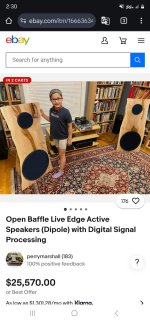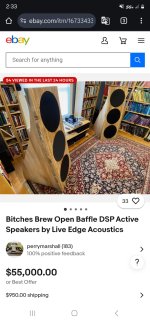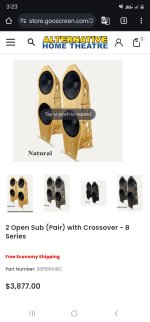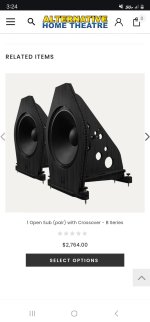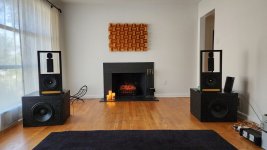Work in progress on this open baffle seeking the good midrange.
After a 8" 22W8534 not convinced

The 8" was replaced by a 6" W18NX001 not match with the woofers. Now the midrange is the MU10RB with the 27DXT as tweeter.

Very fan of the sound, very homogeneous sound and the treble is very realistic with a real 3D dimension. Note the tweeter placement is not very optimal....
Crossover frequency 400Hz-3700Hz LR2.

After a 8" 22W8534 not convinced
The 8" was replaced by a 6" W18NX001 not match with the woofers. Now the midrange is the MU10RB with the 27DXT as tweeter.
Very fan of the sound, very homogeneous sound and the treble is very realistic with a real 3D dimension. Note the tweeter placement is not very optimal....
Crossover frequency 400Hz-3700Hz LR2.
I expect you would have better results with the tweeter as close to the midrange as possible.
dave
dave
Nice 2.5 way open baffle, especially bass and mid, since tweeter is horn, not fully open baffle. I like the construction, but have not personally heard at any show yet.
Wood work is very nice, but mid baffle is too large, this cause low first dipole null (somewhere below 1 kHz), so it is hard to join mid seamlessly even with horn tweeter.Nice 2.5 way open baffle, especially bass and mid, since tweeter is horn, not fully open baffle. I like the construction, but have not personally heard at any show yet.
Why would one want to use waveguides on the back and not on the front. Those recesses at the back do act as pretty bad waveguides. I have made that mistake once, learned my lesson and will never do it again. It measured and sounded pretty horrible compared to a thinner flat baffleVery brief, same concept of open baffle.
These speakers (The Joseph Crowe No. 1695) have had me scratching my head since I first came across them on his website. I agree that the wide baffle on the mids is a potential issue, but I do think that the graph scaling in Edge can make things look worse than they really are. When you model driver and baffle together in Basta!, the results rarely look as bad, even though they incorporate the same baffle diffraction model as Edge. I've actually had a go at modelling the bass and mid of this speaker in Basta! with a passive crossover, and it's possible to get a decent looking on-axis response. Of course, there's still the issue of the off-axis response/directivity.
The thing that really puzzles me is the mid driver - it's a Scanspeak 25W8565-00. This is a very highly rated driver from Scanspeak's Classic line - but it's normailly used as a woofer, crossed low. Here's the response as shown on the factory datasheet:

As you can see, it has a big break-up peak at 2.5 kHz. If you cross low it shouldn't be a big issue, but in this design it's crossed at 1.2kHz, apparently, with a first order filter. On Joseph Crowe's blog post about this speaker he quotes Don Sachs, the original customer these were designed for, as follows: "The crossover is very simple, and the horn and 10 inch midrange drivers have a very gentle slope. There is no need for complexity in the crossover, such as notch filters and the like to tame difficult drivers. The individual drivers were chosen to allow for the simple crossover. Try as I might, I cannot hear any single driver, as the integration is excellent. Lynn Olson looked at the crossover schematic and remarked that the drivers must be really good to pull that off, and it was probably the best dipole design he had ever seen." Now those aren't Joseph Crowe's own words, but if any of it was wrong I guess he wouldn't have put it on his blog.
So I'm puzzled. Lynn Olson actually used the almost identical 01 version of the Scanspeak driver in a bass module for his Ariel speaker, back in the day, and his notes on it warn about the need to deal with the break-up peak, even when crossing low. (See here: https://www2.audiokit.it/ITAENG/KitDiffusori/ARIEL/ArielGoodBass.htm)
I just don't see how you could use that driver up to 1.2 kHz with a low-order filter and no trap.
(PS @kaameelis You have the speaker source density set to 3 in your sims, above - that's quite low, I think. It causes some raggedness which will be reduced significantly if you increase it to 6 or more.)
The thing that really puzzles me is the mid driver - it's a Scanspeak 25W8565-00. This is a very highly rated driver from Scanspeak's Classic line - but it's normailly used as a woofer, crossed low. Here's the response as shown on the factory datasheet:
As you can see, it has a big break-up peak at 2.5 kHz. If you cross low it shouldn't be a big issue, but in this design it's crossed at 1.2kHz, apparently, with a first order filter. On Joseph Crowe's blog post about this speaker he quotes Don Sachs, the original customer these were designed for, as follows: "The crossover is very simple, and the horn and 10 inch midrange drivers have a very gentle slope. There is no need for complexity in the crossover, such as notch filters and the like to tame difficult drivers. The individual drivers were chosen to allow for the simple crossover. Try as I might, I cannot hear any single driver, as the integration is excellent. Lynn Olson looked at the crossover schematic and remarked that the drivers must be really good to pull that off, and it was probably the best dipole design he had ever seen." Now those aren't Joseph Crowe's own words, but if any of it was wrong I guess he wouldn't have put it on his blog.
So I'm puzzled. Lynn Olson actually used the almost identical 01 version of the Scanspeak driver in a bass module for his Ariel speaker, back in the day, and his notes on it warn about the need to deal with the break-up peak, even when crossing low. (See here: https://www2.audiokit.it/ITAENG/KitDiffusori/ARIEL/ArielGoodBass.htm)
I just don't see how you could use that driver up to 1.2 kHz with a low-order filter and no trap.
(PS @kaameelis You have the speaker source density set to 3 in your sims, above - that's quite low, I think. It causes some raggedness which will be reduced significantly if you increase it to 6 or more.)
Last edited:
Congrats to perrymarshall, his speaker is already in two carts, hurry!
https://www.ebay.com/itm/166636348544
https://www.ebay.com/itm/166636348544
Attachments
Bigger brother is not in cart yet, hopefully soon.
https://www.ebay.com/itm/167334336555
https://www.ebay.com/itm/167334336555
Attachments
Open baffle speakers, cheaper than above. You can get open baffle sub separately.
https://store.gooscreen.com/2-open-sub-pair-with-crossover--b-series.html
https://store.gooscreen.com/2-open-sub-pair-with-crossover--b-series.html
Attachments
As your posts show, wide baffle OB is common. In the past it was the dominant approach. As I'm sure you know, though, there are technical issues with it, which have been highlighted more in recent years as understanding of baffle effects has improved, and as people have got more interested in designing for smooth directivity. With a wide baffle, and an increased baffle/driver width ratio, you do get more a more pronounced null on axis, as @kaameelis mentioned, but you also get a bulge in dispersion around that frequency. Below is an Edge sim of the 1695 mid driver and baffle, with microphone at 2 metres, showing on-axis plus 15, 30, 45 and 60 degrees.. Around 1 to 1.2 kHz, you have a null on-axis but a peak off-axis. At 15 and 30 degrees, the level is briefly higher than the on-axis.But I am sure one thing, some of you will object to flawes all over.
It's perfectly possible to build a successful OB speaker this way, though. A wide baffle offers benefits too - the dipole roll-off is pushed right down to below 200 Hz, for one thing.
Try 50dB scale for a start...
Fun fact. Tang Band (TB) often shows their fullrange drivers response in 110dB scale to make them look flat. I have even seen them to go to negative dB scale on bottom. If you make your scale -20 dB to +110dB, all is good.
Btw, in order to make ob bass flat, you simply sacrifice efficiency, and cross lower.
Btw, in order to make ob bass flat, you simply sacrifice efficiency, and cross lower.
- Home
- Loudspeakers
- Multi-Way
- Ultimate Open Baffle Gallery
